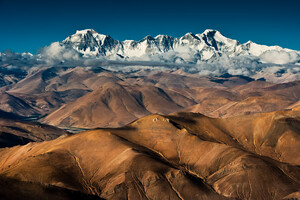Researchers have already identified hundreds of new species of microorganisms.

Scientists from the Chinese Academy of Sciences said that the melting of the glaciers of the Tibetan Plateau could lead to the release of new species of bacteria. They have found 1,000 species of microorganisms here, hundreds of which are still unknown to science, according to IFL Science.
Climate change threatens the Tibetan plateau, so the discovery raises concerns about the spread of potentially dangerous pathogens.
Read also: Scientists have discovered the largest bacterium in the world
During the study, scientists collected surface snow, ice and other samples from 21 glaciers in Tibet in the period from 2016 to 2020. As a result, they found 968 species of bacteria, about 82% of which had not been documented before.
Scientists previously thought that the conditions of glaciers were too extreme for them to live a rich variety of life, but new research has shown that this is far from the case. Last year, researchers described viruses found in a 15,000-year-old glacier that were unlike any before.
Glaciers and ice sheets cover 10% of the Earth's surface and are the largest reservoirs of fresh water on the planet. But in addition to scientific curiosity, there is an urgent need to study them.
The authors of the new study are concerned that the glaciers of the Tibetan Plateau are increasingly melting due to rising temperatures caused by climate change. Scientists fear that bacteria that have been in the ice for thousands of years will find themselves in new conditions after being washed downstream with melting water.
“Modern and ancient pathogenic microbes captured by ice can lead to local epidemics and even pandemics [[] These microorganisms can carry new virulence factors that make plants, animals and humans vulnerable. In addition, virulence factors can be transmitted horizontally within the microbial community through mobile genetic elements […] Interactions between glaciers and modern microorganisms can be particularly dangerous, and potential health risks need to be assessed, ”the study said. >
More importantly, the Tibetan Plateau is known as the “Water Tower of Asia” and is the source of several of the world's largest rivers, surrounded by densely populated areas, including the Yangtze, Yellow River, Ganges and Brahmaputra rivers. If pathogenic bacteria enter here, the consequences can be devastating.
“The release of potentially dangerous bacteria could affect the world's two most populous countries: China and India,” the study authors added.
At the moment, such warnings are preliminary, but scientists stress the need to assess the potential health risks associated with melting glaciers.
Earlier, a team of scientists from New Zealand found that under the shelf Antarctica's glacier in a domed cave is inhabited by swarms of small sea creatures resembling shrimp. They live in a developed ecosystem that has only recently been hidden by glaciers.




